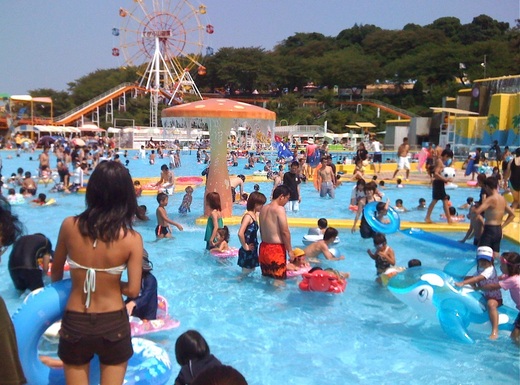|
As Himeji simmers into August there is only one expression you need to know:
“Atsui-naaaa!” No other country to my knowledge substitutes “Good morning” with “Geez it’s hot!” But as temperatures soar and humidity threatens to collapse the atmosphere, these two hyphenated words are all you need to carry a conversation in the Good Hood, my home for the past 14 years. It might go something like this: Atsui-naaa! = Hotter than hell isn’t it! Atsui-na? = Me? Oh I’m surviving. Atsui-na... = Only just... Atsui-na? = Matsui-san’s dog died, didn’t you hear? Atsui-na. = Heatstroke. Atsui-na... = Cremation’s tomorrow... Atsui-na? = Going? Naaa = Nah. Atsui! atsui! = Hear it’ll be hotter than hell. But to the meat of the matter: Summer is for swimming. And just where does one go to cool off in the Good Hood? Well, there’s the Semba River; its waters run swift, cool and teem with life, though not the human kind, for the reason that dozens of neighborhoods lie between its source in the mountains and my house, and the ‘northerners’ tend to muddy the waters for us ‘downstreamers.’ I try to visualise my neighborhood as it stood 50 years ago. My old friend, Ono-san, helps me: she says it was “a lush blanket of rice fields with a river running through it” and shaded by camphor trees where she could swim after school. Nice. But last year a government-funded construction scheme erected a wall along the river’s banks, all but snuffing out that memory. “The neighborhood’s steaming,” howls Ono-san. So these days hot heads and hot bodies are cooled in inflatable pools; huge pink and lavender-coloured things into which pile the kids, and the kids from next door and the friends and cousins of these kids, until Archimedes water displacement theory is enacted and all water flows out and down the street. Returning to the sea from whence it came. So with the river sealed off, the pink inflatables stretched to their limits and the Seto Inland Sea only a vague whiff of salt on the humid air, what to do? What to do? The Shimin Pool, of course! “Shimin” (“Citizens” in Japanese) and “swimmin” are interchangeable words. Coupled with “pool” they both stand for the same thing. Like the watering holes of the Serengeti, the Shimin Pool is where the herds of Himeji city migrate on hot afternoons. By 2pm every patch of wet concrete has been paved over with picnic sheets or shade tents and the pools--a wave pool, current pool, water slide and super warm toddlers’ pool--have become large pots of bobbing, sunburned citizens. By day’s end, when the human tides have receded and the distant thunderheads loom high, dragonflies come down from the nearby mountain to drink at the pools’ edge. This is the best time of day. I don’t see too many of my elderly neighbors at the Shimin Pool. “Too noisy, too crowded!” says Smokin’ Joe Matsumoto, the old kitchener gardener who lives up my street. Privately though, I think he still feels some nostalgia for the public pools; it’s where many of the city’s old timers came of age during their summer holidays, so long ago. Next week: The Good Hood by bicycle!
0 Comments
Leave a Reply. |
This Blog:What is the essence of a traditional Japanese neighbourhood? Writing from my home in Himeji, a castle town in western Honshu, Seaweed Salad Days distills, ferments, presents! Archives
March 2024
Categories
All
|

 RSS Feed
RSS Feed
